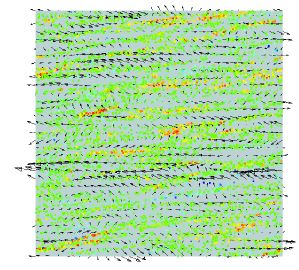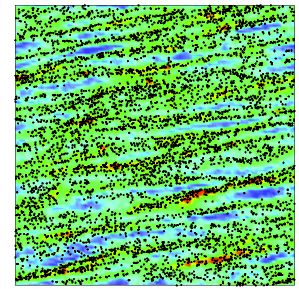

 Skip to navigation
Skip to navigation
Site Primary Navigation:
- About SDSC
- Services
- Support
- Research & Development
- Education & Training
- News & Events
Search The Site:

| USER RESEARCH | Contents | Next
|
|
Reacting Fuel Droplets in Combustion Engines |
|
| FEATURED Farzad Mashayek, University of Hawaii |
|
|
GENERATING VALUESGENERATING KNOWLEDGEREFERENCE F. Mashayek. "Numerical Investigation of Reacting Droplets in Homogeneous Shear Turbulence." Journal of Fluid Mechanics (in press). |
|
|
|
 |
Figure 1. Droplet Distribution
Droplet size distribution and velocity vectors in the plane of mean flow. |
|
|
|
GENERATING VALUESThe simulations were run on NPACI's Cray T90 at SDSC. A set of calculations considered a very large number of fuel droplets and the oxidizer gas with which they interact in the presence of turbulence. The movement of droplets in the turbulent flow was tracked, and the rate of evaporation quantified. Then calculations evaluated the combustion process between the fuel and the oxidizer. Throughout the simulations, values were generated for the amount of temperature and pressure present, as these weigh heavily on the amount of thrust produced by the engine. "We are trying to find average values for temperature, pressure, and velocity when the reaction is occurring under turbulence," Mashayek said. "Using supercomputing resources, we generate instantaneous values, which we can then statistically analyze to deduce the average and fluctuating quantities. Correlations between various fluctuating quantities help us gain insight into the complex phenomenon of two-phase turbulent reacting flows." The simulations were run at very fine resolution, both because the size of the fuel droplets diminishes rapidly as they undergo evaporation, so they interact with finer scales of the flow, and because the data generated will eventually be used to model the same phenomenon. "All the data from the direct numerical simulation is going to be contained in a database that we will use for model generation and validation," Mashayek said. |
Top | Contents | Next |
|
|
|
 |
Figure 2. Reaction Zone
Droplet distribution and reaction zone as visualized by contours of the reaction rate in the plane of mean flow. |
|
|
|
GENERATING KNOWLEDGEThe simulations indicated that the researchers should pay special attention to mechanisms influencing the mixing of the fuel vapor and the oxidizer. "Previous studies had shown that turbulence enhances the rate of reaction," Mashayek said. "Our work indicated that the dispersion of the droplets may also be considered an effective means for improving and controlling the mixing process of fuel and oxidizer." The study revealed that reaction rates are higher in the regions of the flow where there is a larger concentration of droplets, and that there is a tendency for higher reaction rates in the regions with high strain-rate. Mashayek further learned that the reaction zone--the area of increased reaction activity--is aligned with the direction of the mean flow (Figure 2). The chemical reaction that occurs as the fuel combusts decreases the alignment of the fuel vapor with the direction of the mean flow, while increasing the alignment of the oxidizer. "The results will be very useful for model development and model validation," Mashayek said. "However, there is still much more work to be done. For example, the two-phase turbulent reacting flow depends on the time scales for turbulence, evaporation, reaction, and droplet dispersion, and we need to investigate the problem while considering a wider range of variations for various parameter values. We plan to apply for another allocation from NPACI to continue our work." --AF * |
Top | Contents | Next |